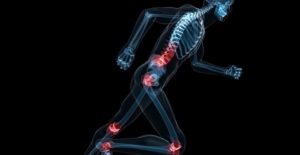What is Ankylosing Spondylitis?

Ankylosing spondylitis is a type of arthritis that is long-term and affects the bones and joints at the base of the spine, where it connects with the pelvis.
It causes these joints to become swollen and inflamed, and eventually, the affected spinal bones will join together. This disease tends to occur more often in males, and patients usually start to show symptoms between ages 15 and 45.
Symptoms of Ankylosing Spondylitis
The first symptoms of AS typically include frequent pain and stiffness in the lower back and buttocks. Initially, discomfort might only be on one side, but the pain is usually dull and diffuse instead of localized. The pain and stiffness are usually worse in the mornings or at night during this stage. Some other early symptoms might include mild fever, loss of appetite, and general discomfort.
Pain
Over time, the pain becomes persistent and usually lasts for at least three months. After months or years, the pain might spread up to your spine and neck as well. It is also possible for pain or tenderness to be felt in the ribs, shoulder blades, hips, thighs, or heels.
Inflammation
The inflammation caused by AS can cause intense fatigue as well. A lot of energy is expended in order for the body to deal with inflammation, and this results in varying levels of fatigue. Mild to moderate anemia can also result from the inflammation, which can contribute tiredness as well.
About one-third of people with AS will also experience inflammation of the eye, a condition called iritis or uveitis, at least once. This inflammation can result in pain, watery or red eyes, blurred vision, and sensitivity to light.
Atypical Symptoms
It is important to note that women may produce more atypical ankylosing spondylitis symptoms than men, which makes it harder to diagnose. For example, many women report that their pain and stiffness started in the neck instead of the lower back.
Advanced symptoms of AS include: chronic, severe pain and stiffness in the back, spine, or peripheral joints; lack of spinal mobility; and possible spinal fusion.
Diagnosis
If you are experiencing any of these symptoms, you need to see a rheumatologist, which is a doctor that specializes in disorders that affect the joints, muscles, tendon, ligaments, connective tissue, and bones. If you have a family history of ankylosing spondylitis, then you are much more likely to have a diagnosis as well. The rheumatologist will take all of this into account, and then take blood work to test for markers of the disease before making a diagnosis.
AS Treatments
The earlier a diagnosis is made, the sooner you can begin treatment that will minimize your symptoms. Some treatments include medication, exercise, physical therapy, posture practices, applications of heat or cold, and surgery.
There are other symptom management tools that can alleviate pain and prevent future discomfort as well. For example, frequent massages can relieve pain. Also, maintaining a healthy body weight and a balanced diet are crucial for the most effective treatment.








